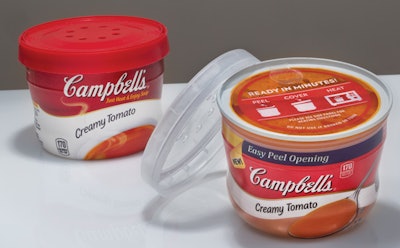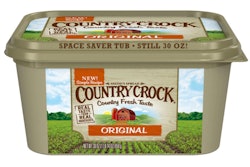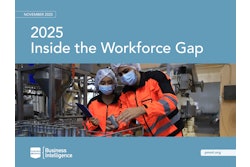One of Camden, NJ-based Campbell Soup Company’s key strategic imperatives is to strengthen its core businesses by connecting with consumers. To that end, Campbell recently conducted market research involving focus groups and mock supermarkets to gather insights about its single-serve microwavable soups.
The insights revealed that consumers want to see actual soup ingredients, right there on the supermarket shelf. “They want to know what they’re getting,” says Lindsay Kohler, Senior Packaging Engineer. In response to this finding, she and her team have spent the last year-and-a-half developing translucent packaging that consists of a contact-clear bowl and overcap, underneath which is a lid of transparent peelable film. The new packaging, which also features a clear PETG label, began reaching grocery retailers in June 2015.
The thermoformed bowl that’s been replaced was white opaque PP/EVOH. Seamed onto the bowl was an aluminum end with a convenient ring-pull, and on top of that was a Campbell’s red overcap with venting holes. Finally, around the bowl was a full wraparound label of foamed polystyrene that provided thermal insulation for handling the container when it came out of the microwave oven.
The new package also has four components. But each one is quite different, beginning with the bowl. Still thermoformed by Silgan Plastic Food Containers in the very same mold used before, it offers contact clarity because Silgan now uses a clarified PP.
The end is still seamed on, but instead of a full-panel aluminum end with a ring pull, the new end features a contact-clear adhesive lamination of polyester and polypropylene that also includes a SiOx barrier coating. This flexible film material is welded onto a metal ring, so as far as the Angelus seamer is concerned, it’s still a metal end being seamed on, even though most of the end consists of flexible film. The end is supplied by Silgan Containers.
According to Kohler, having Silgan supply both the container and the end was quite helpful. “There were definitely some synergies between the two Silgan divisions that moved things along,” says Kohler.
The only change to the snap-fit vented overcap is that it went from opaque Campbell’s red to clarified PP. It’s injection molded by Tech II. Once again, more clarity was the goal behind the changes made.
Opaque label had to go
Considering all the clarity-driven changes noted above, it was obvious that the white opaque foam OPS label had to go. Campbell called on Printpack for a ROSO (Roll On Shrink On) label that could serve as a suitable substitute. And Printpack turned immediately to Klöckner Pentaplast for assistance.
“The label had to be robust in the microwave,” says Kohler, “but getting there involved a learning curve.”
It also involved some arduous testing. First the team tried a Klöckner PETG shrink film with a 65% shrink force, only to discover that the label would pull down from the top of the container when in the shrink tunnel. But there was good news, too: The PETG label material stood up nicely in the microwave oven.
Based on these early results, says Dave Kater, Business Manager of Specialty Films at Klöckner, “We suggested a Pentalabel® shrink film with a relatively low shrink force of about 45%. We also suggested a thickness of 50 microns. We’d started to develop this iteration of PETG roll-sleeve film for another application as an alternative to high-shrink film and thought it would work well for Campbell’s microwavable soups.”
In addition to the label’s ability to perform in the microwave, another key consideration for Campbell revolved around keeping capital expenditures to a minimum. In other words, management wanted a label that would perform on existing labeling equipment that had been used for the OPS foam labels. This was slightly complicated by the fact that a Krones labeler is used at one of the two Campbell facilities where the microwavable soups are produced while at the other facility a Trine machine is used.
At the Maxton, NC, plant, a Krones Contiroll carousel labeler uses radiant heat to shrink the label rather than steam. But according to Kohler, “The only expenses we had were buying perforation rolls and new knives for the cutting drum, because foam is softer than PETG.” Says Dave Niemuth, Division Director of Labeling at Krones, “Campbell has been using our Contiroll labeler for quite some time, which optimally runs at 400 labels per minute. Klöckner Pentaplast is a great company to work with, very market oriented and great customer service.”
Meanwhile, at the Napoleon, OH, plant where a Trine Model 4500 inline roll-fed labeler has been in use for 15 years, the new label runs the same as the previous OPS foam label with no change at all in the tooling. “It’s a big win for Campbell,” says George Michaels, Regional Sales Executive at Trine. “We worked with Klöckner Pentaplast going in. They made the label drop right in place and run.”
Also worth noting is that with the introduction of this new package, heating directions were modified. Cooking time in the microwave oven was reduced from 1:45 to 1:30. “We found that reducing the cook time by 15 seconds provided the consumer with an acceptable experience, both from a handling and eating perspective,” says Kohler. Also modified was the retort cook process to avoid overpressurization that could blow off the overcap during microwaving.
More changes
In choosing the Pentalabel® shrink film with a 45% shrink force, says Kohler, one adjustment had to be made in label application. While a yellow adhesive had been used on the OPS label, now a clear adhesive is used because it enhances overall container clarity.
In looking back over the process that led to picking the Pentalabel shrink film label, Kohler adds that on top of the fact that it performs as well as it does, it’s sourced domestically. This was also very important, she says.
Late in the game, after all the rigorous label testing, it was discovered—to Kohler’s chagrin—that the graphics on the label didn’t pop. “The clear label had no solid background,” she says, “But that was solved with two hits of white.” The white ink gives the label enough opacity to pop the graphics’ colors, specifically Campbell’s custom red. Otherwise, there were no changes to the flexo plates used by Printpack or to any other aspect of the printing process to print the new label. Graphics, however, were updated based on some of the findings in the marketing research.
One last thing needed attention as the new packaging materials made their way onto store shelves. It involved the filling and retorting line, where a nitrogen backflush tunnel had to be inserted between filling and seaming of the new end. When a full-panel aluminum end was in use, there was no chance of oxygen permeating through the end. But now the full-panel end consists not of aluminum but of a flexible film with a SiOx coating. While it certainly provides a good oxygen barrier, it is not the same as metal. By flushing the headspace with nitrogen just before the end is seamed on, Campbell displaces residual oxygen in a way that permits them to keep the same one-year shelf life.
The new packaging format that emerged from development to the marketplace is now deployed on more than 30 microwavable varieties from the company’s four line extensions: Campbell’s Classic, Campbell’s Chunky™, Campbell’s Healthy Request®, and Campbell’s Homestyle™.
Of Campbell’s collaboration with Printpack, Kohler says, “Their technical support is phenomenal. They were there with lots of advice during the learning curve.” In turn, Lenora Phillips at Printpack says, “Klöckner Pentaplast knew which film to use and offered options in the beginning when the solution was not apparent.”
It’s too early to say how the new translucent packaging will affect sales figures for Campbell’s single-serve microwavable soups. But the three key stakeholders involved—soup maker, label converter, and label film supplier—are mighty pleased at how little the overall Campbell Soup infrastructure had to change as the new package made its way out of development and into the marketplace.




















